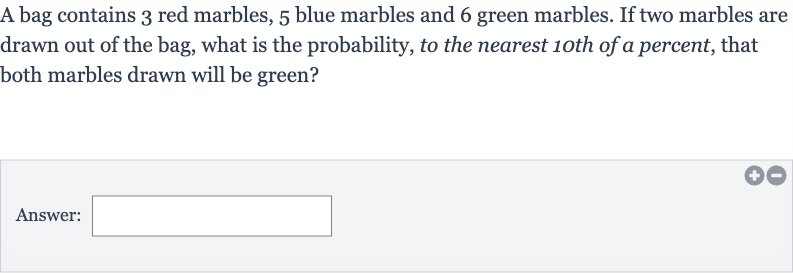AI tutor
Welcome to Bytelearn!
Let’s check out your problem:

A bag contains red marbles, blue marbles and green marbles. If two marbles are drawn out of the bag, what is the exact probability that both marbles drawn will be blue?Answer:
Full solution
Q. A bag contains red marbles, blue marbles and green marbles. If two marbles are drawn out of the bag, what is the exact probability that both marbles drawn will be blue?Answer:
- Determine total number of marbles: Determine the total number of marbles in the bag.The bag contains red marbles, blue marbles, and green marbles. So, the total number of marbles is .
- Calculate total number: Calculate the total number of marbles. red + blue + green = marbles in total.
- Determine probability of first blue marble: Determine the probability of drawing the first blue marble. The probability of drawing a blue marble on the first draw is the number of blue marbles divided by the total number of marbles. Probability of first blue marble = Number of blue marbles / Total number of marbles = .
- Determine new total number: Determine the new total number of marbles after one blue marble is drawn. After drawing one blue marble, there are blue marbles left and the total number of marbles is now (since one marble has been removed and not replaced).
- Determine probability of second blue marble: Determine the probability of drawing the second blue marble. The probability of drawing a second blue marble after the first one has been drawn is the number of remaining blue marbles divided by the new total number of marbles. Probability of second blue marble = Remaining blue marbles / New total number of marbles = .
- Calculate combined probability: Calculate the combined probability of both events happening consecutively.The probability of both events (drawing two blue marbles in a row) is the product of the probabilities of each individual event.Combined probability = Probability of first blue marble Probability of second blue marble = .
- Perform multiplication: Perform the multiplication to find the exact probability.Combined probability = .
- Simplify fraction: Simplify the fraction to its lowest terms. can be simplified by dividing both the numerator and the denominator by the greatest common divisor, which is ..
More problems from Probability of independent and dependent events
QuestionGet tutor help
QuestionGet tutor help
QuestionGet tutor help
QuestionGet tutor help
QuestionGet tutor help
QuestionGet tutor help
QuestionGet tutor help
QuestionGet tutor help
QuestionGet tutor help
